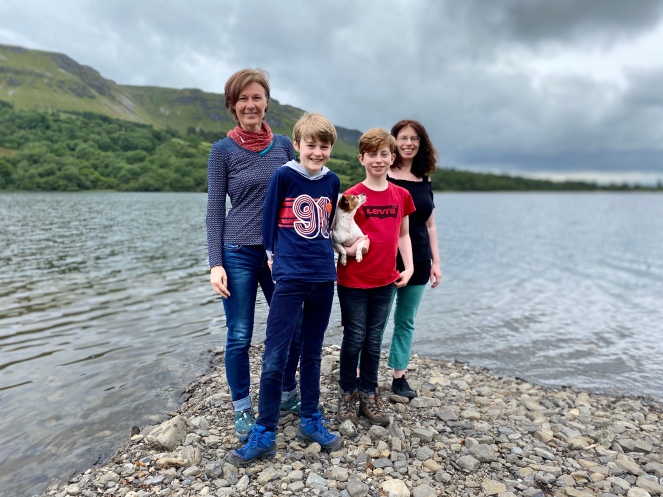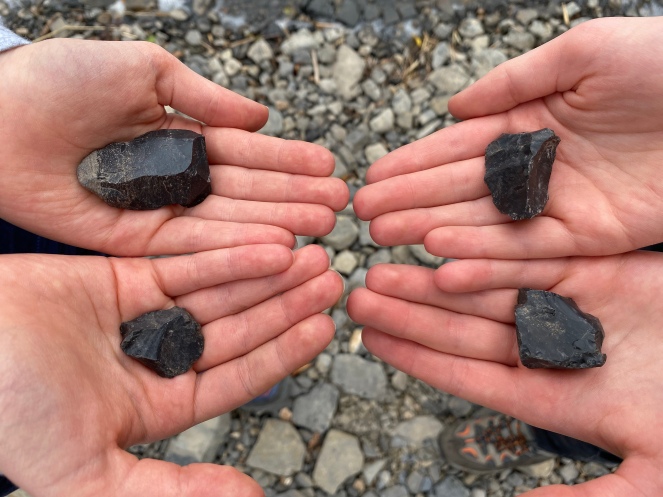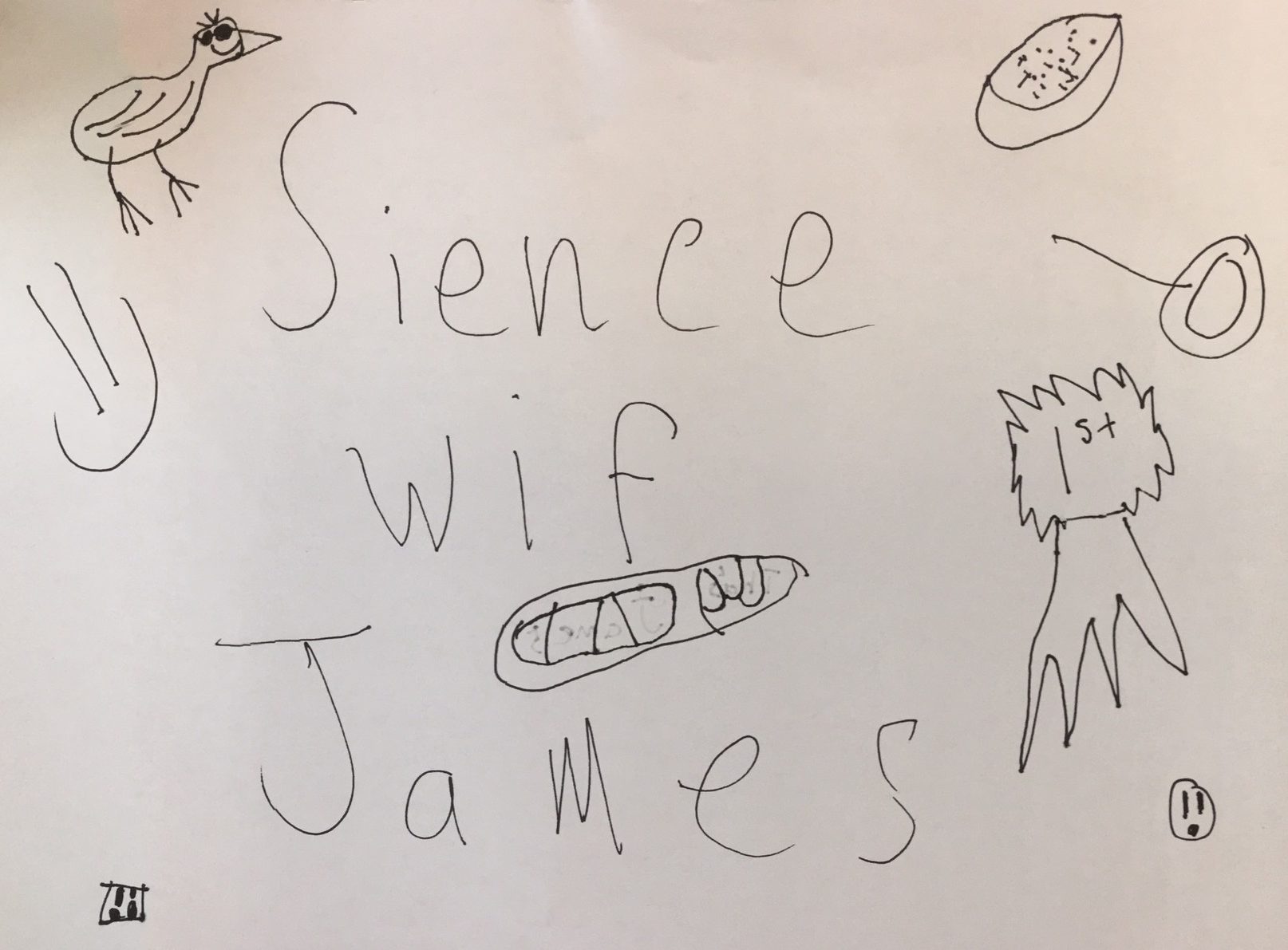Press Release: Hundreds of Prehistoric Tools discovered during lakeshore picnic, Sligo 13 August 2020
Main Points
- Friends discover prehistoric site on shore of Glencar Lake while having a picnic
- 930 pieces of worked chert discovered
- The discovery indicates that prehistoric people were visiting Glencar Lake, at least 4,000 years ago and possibly up to 6,000 years ago, to knap chert and make stone tools
- Most of what was left behind was the debitage (waste) from the manufacture of the tools, but some finished stone tools also survive
- Prehistoric people would have come to Glencar Lake for fishing, boating, washing
- The chert tools may have been used for gutting and cleaning fish, woodworking, basketry, preparing food etc.
Taking advantage of the easing lockdown restrictions, two families planned to enjoy a socially distant picnic at Glencar Lake, on the borders of Counties Sligo and Leitrim. What they hadn’t expected was that they would discover almost 1,000 prehistoric stone tools by the lakeshore.
Marion Dowd and her son, Fiachra (12), Catherine Pineau and her son Yann (10), had all enjoyed a walk to Sruth in Aghaidh An Aird, also known as the Devil’s Chimney, the tallest waterfall in Ireland. They followed the waterfall’s stream down to where it flowed into Glencar Lake. As the boys scouted around for a suitable place to have a picnic, Marion, a Lecturer in Prehistoric Archaeology at IT Sligo, noticed a prehistoric stone tool lying on the ground. On closer inspection, Marion noticed more and more stone tools, and realised that they had discovered a previously unrecorded archaeological site. Marion immediately reported the discovery to the National Monuments Service and the National Museum of Ireland. The site has now been assessed and recorded as a Lithic Scatter or Knapping Floor, a place where people sat and knapped stone such as chert or flint, and worked them into usable tools.
“This was the last thing we had expected on our day out. I took the opportunity to explain to Fiachra and Yann what chert looks like and how it would have been worked. Basically, families sat at this location thousands of years ago enjoying the lake just as we are now in 2020” said Marion. 930 pieces of worked chert were discovered at the lakeshore. Stone tools such as these were commonly made and used up until 4,000 years ago and they could be possibly up to 6,000 years old. The Knapping Floor is located over a 16m x 13m area. This part of the lakeshore would have been an area of dry land in prehistory, but over time the rising water level of Glencar Lake submerged it. The site was exposed for a short period during early June due to falling water levels as a result of the recent dry and warm weather, but was submerged once more just two weeks later.
The discovery provides evidence for the first time that prehistoric people were visiting Glencar Lake, which would have been an attractive place for fresh drinking water, fishing, boating and washing. Glencar Lake is home to a variety of waterfowl and fish, including seatrout, brown trout and salmon, which would have been important food resources for prehistoric people. Previous discoveries around the lake were limited to ringforts and crannogs, settlement sites that occur much later in our history and are typically dated to the Early Medieval periods.
Archaeologists Dr Marion Dowd and Dr James Bonsall formally inspected and recorded the site, with support from the National Monuments Service, removing all the stone tools which will be deposited with the National Museum of Ireland for further analysis. Most of the lithics recovered at the Glencar Knapping Floor are known as ‘debitage’ (waste), tiny pieces of stone chipped away during the manufacture and shaping of tools. Most of the finished stone tools would have been taken away from the Knapping Floor and used for gutting and cleaning fish, woodworking and basketry working. Some finished stone tools were found at the lakeshore site, including a convex scraper dating to the Neolithic or Bronze Age. This scraper would have been used for activities such as cleaning animal hides, perhaps preparing fish, and was left behind at Glencar Lake up to 6,000 years ago.
The newly identified site at Glencar Lake is one of just 98 lithic scatters in Ireland, and one of just four from Counties Sligo and Leitrim.
Contact
Captions for Accompanying Images:
Image 1: The Glencar Lake Knapping Floor Site, dryland exposed in early June 2020
Image 2: The Glencar Lake Knapping Floor Site is once more submerged beneath the waters of Glencar Lake (23 June 2020).

Image 3: Two picnicking families – (l-r) Catherine Pineau, Yann McGuinness, Fiachra Dowd and Marion Dowd – discover the previously unrecorded prehistoric site.

Image 4: (l-r) Yann McGuinness and Fiachra Dowd hold four of the stone tools they discovered whilst picnicking at Glencar Lake.

Image 5: Four of the stone tools discovered at the Glencar Lake Knapping Floor Site.

Image 6: Dr Marion Dowd holds a chert scraper discovered at the Glencar Lake Knapping Floor Site.

Image 7: Dr Marion Dowd holds a chert scraper at the Glencar Lake Knapping Floor Site.

Image 8: Dr James Bonsall recording the archaeological site using a GPS.

Image 9: A distribution plot of lithic frequency found at Glencar Lake.

